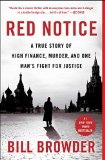Summary | Excerpt | Reviews | Beyond the Book | Read-Alikes | Genres & Themes | Author Bio

A True Story of High Finance, Murder, and One Man's Fight for Justice
by Bill BrowderThis article relates to Red Notice
The title Red Notice refers to one of the many alerts issued by Interpol, the world's largest international police organization.
The idea of an international police force was originally proposed at the First International Criminal Police Congress in Monaco in 1914, although the organization didn't come into being until an initiative was passed in 1923 at the International Criminal Police Congress in Vienna. Formed as the International Criminal Police Commission (ICPC) headquartered in Vienna, it fell under Nazi Germany's control in 1938 and was moved to Berlin in 1942. After World War II, ICPC was reformed as Interpol under the auspices of Belgium, and it was granted official status by the United Nations in 1949. (The name "Interpol," often written INTERPOL, is a concatenation of "International" and "Police.")
Interpol is currently comprised of 190 member countries. Based in Lyon, France, it also has seven regional offices (Buenos Aires, Argentina; San Salvador, El Salvador; Yaoundé, Cameroon; Abidjan, Cote d'Ivoire; Nairobi, Kenya; Harare, Zimbabwe; and Bangkok, Thailand), and each of the member countries has a National Central Bureau (NCB). Its annual budget is 78 million euros (approximately U.S. $88 million), which is primarily composed of contributions by member countries.
 The organization's goal is to facilitate cooperation between countries' law enforcement officers, including where no diplomatic relations exist. Because of its international nature it functions as an administrative liaison, able to navigate language, law and procedural differences that may arise between two countries' police forces. In addition, Interpol provides training, investigative support and crime trend analyses to its member countries. Its officers cannot make arrests, and work as an informational network only, and Interpol's constitution prohibits "any intervention or activities of a political, military, religious or racial character."
The organization's goal is to facilitate cooperation between countries' law enforcement officers, including where no diplomatic relations exist. Because of its international nature it functions as an administrative liaison, able to navigate language, law and procedural differences that may arise between two countries' police forces. In addition, Interpol provides training, investigative support and crime trend analyses to its member countries. Its officers cannot make arrests, and work as an informational network only, and Interpol's constitution prohibits "any intervention or activities of a political, military, religious or racial character."
An Interpol notice is "an international request for cooperation, or an alert allowing police in member countries to share critical crime-related information." A country's law enforcement officials issue a request to their NCB, which in turn requests that the General Secretariat issue the notice.
Interpol issues several different types of notices:
Interpol issued 13,637 notices in 2013, of which 8,857 were Red Notices.
Graphic of red notice from 9 Bedford Row International
Filed under Society and Politics
![]() This "beyond the book article" relates to Red Notice. It originally ran in February 2015 and has been updated for the
October 2015 paperback edition.
Go to magazine.
This "beyond the book article" relates to Red Notice. It originally ran in February 2015 and has been updated for the
October 2015 paperback edition.
Go to magazine.
We have to abandon the idea that schooling is something restricted to youth...
Click Here to find out who said this, as well as discovering other famous literary quotes!
Your guide toexceptional books
BookBrowse seeks out and recommends the best in contemporary fiction and nonfiction—books that not only engage and entertain but also deepen our understanding of ourselves and the world around us.